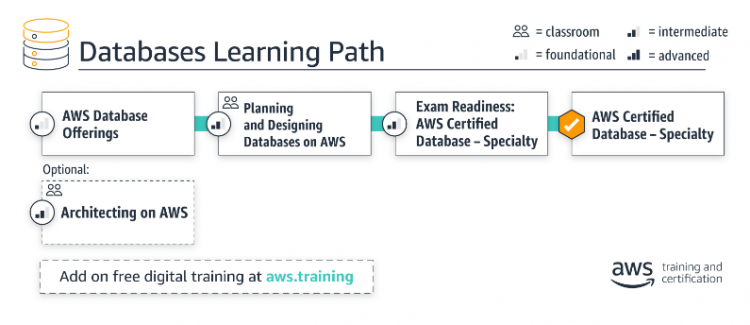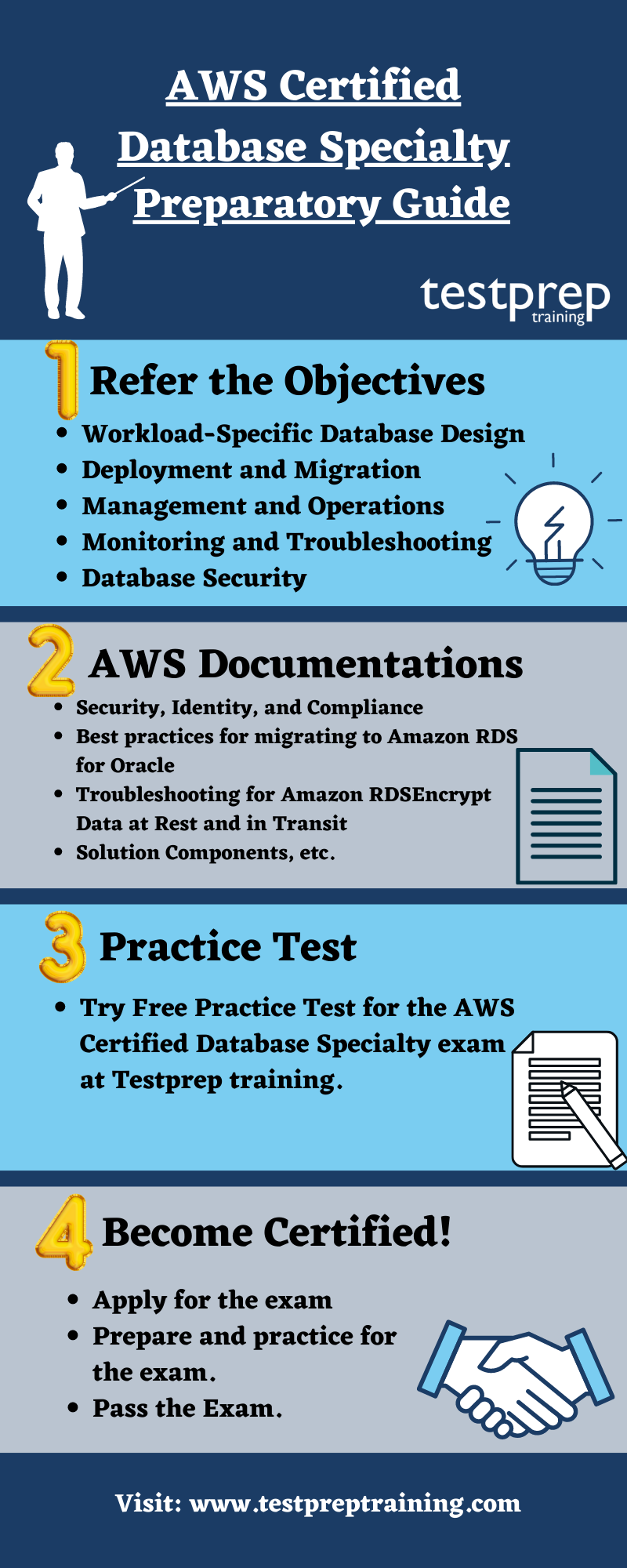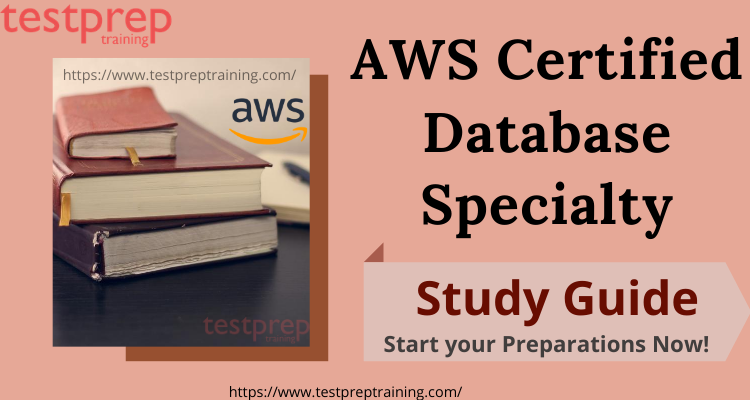Earning an industry-recognized certification from AWS validates the candidate’s expertise in the extent of AWS database services and stimulates the performance of database technology to drive the organization’s business transformation. AWS Certified Database- Specialty certification is designed for candidates who show a database-focused role. This exam verifies an examinee’s general understanding of databases, comprising the concepts of design, deployment, migration, access, automation, monitoring, maintenance, security, and troubleshooting. Moreover this exam builds credibility and confidence by highlighting your ability to design, recommend, and maintain the optimal AWS database solution for a use case
Skills Validated
The AWS Certified Database- Specialty exam validates your expertise in –
- Firstly, understanding and differentiating the key features of AWS database services
- Then, Analyssing needs and requirements to recommend and design appropriate database solutions using AWS services
Who should take this exam?
The AWS Certified Database Specialty exam is focused on developing your skills and expertise. This exam is a brand-new addition among AWS Specialty certifications, i.e., Database Specialty, is ideal for IT professionals related to database-focused roles.
AWS Certified Database – Specialty Learning Path
The learning path of AWS is designed for individuals who plan, design, maintain or manage AWS database services to successfully optimize data strategy and for those who can learn about planning and designing databases using AWS services.

Study Guide for AWS Certified Database- Specialty Exam
The roadmap to your success is only complete with the help of right preparatory resources. You need to stay consistent and determined. Moreover you must follow a study pattern while learning from authentic and genuine resources. This step by step AWS Certified Database – Specialty Study Guide will be your support throughout your journey towards the exam. Lets discuss step by step.

Step 1: Visit the AWS Certified Database Specialty Official Website
Visiting the AWS official website is an essential step while preparing for the exam like AWS Certified Database Specialty. The official site offers a lot of reliable information and sources which is very helpful in preparing for the exam. The resources such as study guide, sample papers, whitepapers, documentation, faqs, etc. You can find all such important things on the official page. Familiarising with the exam course is essential before commencing on with your preparations. The exam course acts as the AWS Certified Database – Specialty Blue Print. Therefore refer the Official Site and Learn about the following 5 domains that this exam covers-
AWS Database Specialty Updated Course Outline
The AWS Certified Database Specialty exam covers the latest and updated course outline –
Module 1: Explain Workload-Specific Database Design (26%)
1.1 Learn to select suitable database services for specific types of data and workloads.
- Understand the differences between ACID vs. BASE workloads
- Understand suitable uses of types of databases including relational, key-value, document, in-memory, graph, time series, ledger (AWS Documentation: Database)
- Understand and identify use cases for persisted data vs. ephemeral data (AWS Documentation: Amazon EC2 instance store)
1.2 Learn about the strategies for disaster recovery and high availability.
- Understanding and selecting Region and Availability Zone placement to optimize database performance (AWS Documentation: Choose Regions and Availability Zones to minimize latency)
- Understanding and determining implications of Regions and Availability Zones on disaster recovery/high availability strategies (AWS Documentation: Disaster recovery options in the cloud)
- Understanding and differentiating use cases for reading replicas and Multi-AZ deployments (AWS Documentation: Multi-AZ deployments for high availability)
1.3 Learn to design database solutions for performance, compliance, and scalability.
- Understanding and recommending serverless vs. instance-based database architecture (AWS Documentation: Understanding database options for your serverless web applications)
- Understanding and evaluating requirements for scaling read replicas (AWS Documentation: Working with MySQL read replicas, Working with read replicas)
- Understanding and defining database caching solutions (AWS Documentation: Database Caching, Caching strategies)
- Understanding and evaluating the implications of partitioning, sharding, and indexing (AWS Documentation: Sharding with Amazon Relational Database Service, Choosing the Right DynamoDB Partition Key)
- Understanding and determining appropriate instance types and storage options (AWS Documentation: Amazon EC2 Instance Types)
- Understanding and determining auto-scaling capabilities for relational and NoSQL databases (AWS Documentation: Managing throughput capacity automatically with DynamoDB auto scaling, AWS Management Console with DynamoDB auto scaling)
- Understanding and determining the implications of Amazon DynamoDB adaptive capacity (AWS Documentation: Best practices for designing and using partition keys effectively)
- Understanding and determining data locality based on compliance requirements (AWS Documentation: Addressing Data Residency with AWS)
1.4 Learn to compare the costs of database solutions
- Understanding and determining cost implications of Amazon DynamoDB capacity units, including on-demand vs. provisioned capacity (AWS Documentation: Read/write capacity mode, Pricing for Provisioned Capacity, Pricing for On-Demand Capacity)
- Understanding and determining costs associated with instance types and automatic scaling (AWS Documentation: Amazon EC2 Auto Scaling)
- Understanding and designing for costs including high availability, backups, multi-Region, Multi-AZ, and storage type options (AWS Documentation: Multi-AZ deployments for high availability, Amazon RDS Multi-AZ)
- Understanding and comparing data access costs (AWS Documentation: Analyzing your costs with AWS Cost Explorer)
Module 2: Explain Deployment and Migration (20%)
2.1 Learn to automate database solution deployments.
- Understanding and evaluating application requirements to determine components to deploy (AWS Documentation: Evaluate your applications)
- Understanding and choosing suitable deployment tools and services (e.g., AWS CloudFormation, AWS CLI) (AWS Documentation: Using the AWS Command Line Interface, AWS CloudFormation best practices)
2.2 Learn to determine data preparation and migration strategies.
- Understanding and determining the data migration method (e.g., snapshots, replication, restore) (AWS Documentation: Restoring from a DB snapshot, Restore an Amazon RDS DB instance from a DB snapshot)
- Understanding and evaluating database migration tools and services (e.g., AWS DMS, native database tools) (AWS Documentation: Migration with native database tools and AWS DMS)
- Understanding and preparing data sources and targets (AWS Documentation: Configuring data target nodes, Creating a dataset from a database)
- Understanding and determining schema conversion methods (e.g., AWS Schema Conversion Tool) (AWS Documentation: AWS Schema Conversion Tool)
- Understanding and determining heterogeneous vs. homogeneous migration strategies (AWS Documentation: Heterogeneous database migration, Homogeneous database migration)
2.3 Learn to execute and validate data migration.
- Understanding and designing and script data migration (AWS Documentation: Best practices for AWS Database Migration Service, Database Migration Step-by-Step Walkthroughs)
- Understand and run data extraction and migration scripts (AWS Documentation: Extracting data from on-premises databases, Migrating data from an on-premises data, Database Migration Step-by-Step Walkthroughs)
- Understanding and verifying the successful load of data (AWS Documentation: Verifying that the data loaded correctly)
Module 3: Explain Management and Operations (18%)
3.1 Learn to determine maintenance tasks and processes.
- Understanding and accounting for the AWS shared responsibility model for database services (AWS Documentation: Shared Responsibility)
- Understanding and determining appropriate maintenance window strategies (AWS Documentation: AWS Systems Manager Maintenance Windows, Maintenance window scheduling and active period options)
- Understanding and differentiating between major and minor engine upgrades (AWS Documentation: Upgrading a DB instance engine version)
3.2 Learn to determine backup and restore strategies.
- Understanding and identifying the need for automatic and manual backups/snapshots (AWS Documentation: Comparing Automatic and Manual Snapshots, Amazon EBS snapshots)
- Understanding and differentiating backup and restore strategies (e.g., full backup, point-in-time, encrypting backups cross-Region) (AWS Documentation: Creating backup copies across AWS Regions)
- Understanding and defining retention policies (AWS Documentation: Implement data retention policies for each class, Work with retention rules)
- Understanding and correlating the backup and restore to recovery point objective (RPO) and recovery time objective (RTO) requirements (AWS Documentation: Plan for Disaster Recovery (DR), Disaster recovery options in the cloud)
3.3 Learn to manage the operational environment of a database solution.
- Orchestrate the refresh of lower environments (AWS Documentation: Updating compute environments, Orchestrating database refreshes for Amazon RDS and Amazon Aurora)
- Implement configuration changes (e.g., in Amazon RDS option/parameter groups or Amazon DynamoDB indexing changes) (AWS Documentation: Working with parameter groups, Best practices for configuring parameters for Amazon RDS)
- Automate operational tasks (AWS Documentation: AWS Systems Manager Automation, Working with runbooks)
- Take action based on AWS Trusted Advisor reports (AWS Documentation: Get started with AWS Trusted Advisor)
Module 4: Explain Monitoring and Troubleshooting (18%)
4.1 Learn to monitor and alert strategies.
- Understanding and evaluating monitoring tools including Amazon CloudWatch, Amazon RDS Performance Insights, database native (AWS Documentation: Overview of monitoring metrics in Amazon RDS, Monitoring DB load with Performance Insights on Amazon RDS)
- Understanding and determining appropriate parameters and thresholds for alert conditions (AWS Documentation: Working with threshold alerts in Amazon QuickSight, Working with alerts)
- Understanding to use tools to notify users when thresholds are breached including, Amazon SNS, Amazon SQS, Amazon CloudWatch dashboards) (AWS Documentation: Using Amazon CloudWatch alarms)
4.2 Learn to troubleshoot and resolve common database issues.
- Understand and identify, evaluate, and respond to categories of failures including troubleshooting connectivity; instance, storage, and partitioning issues) (AWS Documentation: Troubleshoot instances with failed status checks)
- Understanding and automating responses when possible (AWS Documentation: Options for Automating Response)
4.3 Learn to optimize database performance.
- Understanding and troubleshooting database performance issues (AWS Documentation: Troubleshooting for Amazon RDS)
- Understanding and identifying suitable AWS tools and services for database optimization (AWS Documentation: Best practices for Amazon RDS)
- Understanding and evaluating the configuration, schema design, queries, and infrastructure to improve performance
Module 5: Explain Database Security (18%)
5.1 Learn to Encrypt data at rest and in transit.
- Understand to encrypt data in relational and NoSQL databases (AWS Documentation: Encrypting Amazon RDS resources, Using SSL/TLS to encrypt a connection to a DB instance)
- Understand to apply SSL connectivity to databases (AWS Documentation: Using SSL/TLS to encrypt a connection to a DB instance)
- Understand to implement key management (e.g., AWS KMS, AWS CloudHSM) (AWS Documentation: AWS Key Management Service, AWS CloudHSM)
5.2 Learn to evaluate auditing solutions.
- Understand to determine auditing strategies for structural/schema changes (e.g., DDL) (AWS Documentation: Database audit logging, Handling schema updates)
- Understand to determine auditing strategies for data changes (e.g., DML) (AWS Documentation: DML auditing for Amazon DocumentDB (with MongoDB compatibility))
- Understand to determine auditing strategies for data access (e.g., queries) (AWS Documentation: Database audit logging)
- Understand to determine auditing strategies for infrastructure changes (e.g., AWS CloudTrail) (AWS Documentation: AWS CloudTrail)
- Understand and enable the export of database logs to Amazon CloudWatch Logs (AWS Documentation: Exporting log data to Amazon S3)
5.3 Learn to determine access control and authentication mechanisms.
- Recommend authentication controls for users and roles including IAM, native credentials, Active Directory (AWS Documentation: Security best practices in IAM, Using the AWS Directory Service identity provider)
- Recommend authorization controls for users including policies (AWS Documentation: Policies and permissions in IAM)
5.4 Learn to identify potential security vulnerabilities within database solutions.
- Understand to determine security group rules and NACLs for database access (AWS Documentation: Controlling access with security groups, Control traffic to subnets using Network ACLs)
- Understand to identify relevant VPC configurations (e.g., VPC endpoints, public vs. private subnets, demilitarized zone) (AWS Documentation: VPC with public and private subnets (NAT), Amazon VPC)
- Understand to determine appropriate storage methods for sensitive data (AWS Documentation: Best practices for securing sensitive data in AWS data stores)
Step 2: AWS Certified Database – Specialty Training
You can also opt for the AWS training programs. The AWS offers training programs on every exam. The training programs for a particular exam contain all information of the exam such as description, intended audience, delivery method, duration etc. Therefore you should join a training program to gain knowledge and skills for AWS Certified Database Specialty.
Step 3: Books and Guides
The next step in the preparatory guide should be books and study guides. You need to find those books which are enriched with information. Finding a good AWS Certified Database – Specialty Book may be a difficult task, but in order to gather the knowledge and skills, the candidate has to find, read and understand.
Step 4: Join a Study Group
Staying updated with the current changes and updates is the need of preparations. Therefore, joining a study group or online forum is very necessary. Such online forums provide expert experience and so it is advisable to join them. There are multiple benefits, such as connecting with the candidates who are on the same path as you or clarifying your doubts that may arise during the preparations.
Step 5: Practice Test
Finally, it is time to check your preparations. Self-Evaluation is the key and hence your next step is to attempt AWS Database Specialty Practice Exam. The more you’re going to practice, the better for you. These practice tests provide you with the real exam environment and also help you analyse areas that need improvement. Strengthening your weaker domains will surely help you pass with flying colours. Also, attempting multiple practice tests is vital to boost your confidence So, outperform yourself with each subsequent test to be fully ready on the exam day. Start practising Now!



